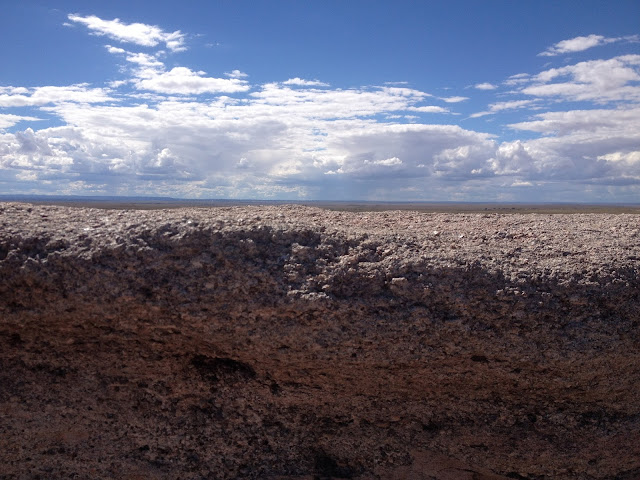Sasha went along for the ride today, and had hopes of a couple of walks along the way!
The Rainbow Forest Museum and Visitors Center has wondrous displays of dinosaur fossils that have been found in the park, as well as providing a trail through a series of giant petrified logs.
The landscape is littered with the remnants of trees from millions of years ago.
Millions of years ago, this area was a sub-tropical plain crisscrossed with multiple rivers. The climate approximated that of present day Costa Rica, with thousands of dinosaurs competing in and out of the water for plants and small animals. Heavily forested with huge grass stalks that reached hundreds of feet into the air and tropical trees of all kinds. As the trees died and fell, they were immediately covered with mineral rich composite soils, as seen in this photo.
As the centuries passed, the minerals gradually replaced the cellular structure of the plants, since there was an absence of oxygen and microbes that would have allowed total decay.
This petrified tree root is just about as tall as Donna!
Many of these trees are huge!
As we left the south entrance, we entered a variety of desert landscapes and badlands.
At Cristal Forest Trail, the path leads through hundreds of petrified trees and fragments.
This "Long Log" is over 100 feet long! It's the remnant of a large stalk of grass related to our present day Horsetail Grass.
At times the distant vistas competed for our attention with the petrified wood!
As the logs crystalized, and were undermined by water and soil movement, they broke into fairly regular segments, exposing their inner beauty.
Again with the distant views!
This photo of a petrified log was taken in 2005. In 2007, a ranger passing on his rounds noticed something different in the landscape.
He soon realized that Mother Nature and her minions, water and wind, had once again irrevocably changed the landscape.
This views in the park are breathtaking.
A distant storm, the last of the official Monsoon Season, had dumped enough rain to cause the desert washes to run fast for a short time. It has always amazed me that such a large amount of porous sand could have so much water run off!
A formation called The Tepees shows how different layers of sediment were laid down over millions of years.
Newspaper Rock, near the Puerto River, is so called because of the 650 plus or minus different petroglyphs etched into the rocks here. Possibly used as depictions of daily life or of migration directions, the drawings remain for the most part, a mystery.
The storm clouds were gathering as we approached the northern part of Petrified Forest National Park.
Just a few hundred yards north of I-40, a major east-west artery, the remains of the famous Route 66 highway can be still picked out of the scrub brush. This '32 Studebaker seems still to be trying to get it's family to the promised land in the west.
Entering the Painted Desert Wilderness Area, we saw first hand why the name was chosen. At about 227 million years ago, during the late Triassic Period, layers of sandstone were laid down. As North America and South America slowly drifted apart over the next 180 million years, the sandstone and mudstone was subjected to uplift, burial, and erosion to create the beautiful formations we see today.
A lonely hawk floated in the air currents over the ravines and canyons looking for a meal.
The Painted Desert Inn National Historic Landmark was built of petrified wood and other native stone prior to 1920 by Herbert David Lore, and was registered with the land office in 1924, fulfilling responsibilities under the Homesteading Act. For twelve years, Lore operated the Inn, named the "Stone Tree House" as a tourist attraction, renting rooms for two to four dollars a night. Unfortunately, the building had been built on a seam of clay that expanded and contracted in response to moisture, resulting in cracks in the walls and water damage. The solution? A stroke of genius, really, because Lore sold the building and four sections of land to the National Park Service for $59,400! The CCC refurbished the structure in the '30's, and the Inn reopened in 1940, suppling Route 66 travelers with meals, souvenirs, and lodging. The Inn closed in 1942 due to World War II restrictions, but reopened again in the late '40's under the Fred Harvey banner. Harvey had connections with the Santa Fe Railroad, and provided rail travelers with accommodations that were know for comfort and quality. Harvey's hotels were also known for the Harvey Girls, who were recruited from the East and Midwest to serve customers. The girls had to be of good moral character, have an eighth grade education, display good manners, and be neat and articulate. Their contract stipulated that they could not marry and must abide by all company rules during their employment. They were given a train ticket to their destination, a uniform, wages, and room and board. Harvey Girls have become an American legend, and the Harvey Girls of the Painted Desert Inn still have local ties.
The Inn is now open as an Historic Landmark, as a perfect example of Pueblo Revival Style architecture.
The view from the hotel veranda is spectacular.
A perfect day trip through beautiful country!






































No comments:
Post a Comment